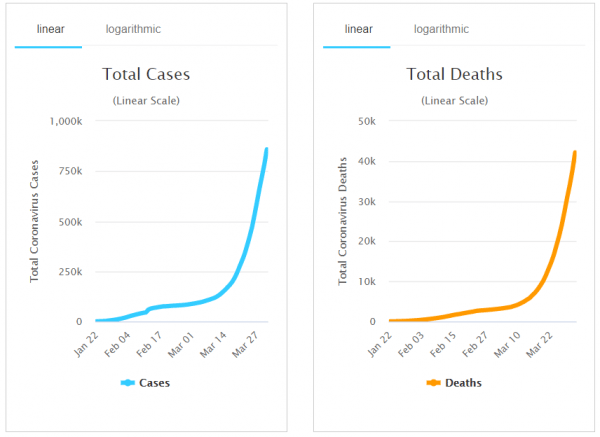
Right now, hundreds of millions of people all over the world are in lockdown. It is the largest quarantine in all of human history.
China, Italy, France, Denmark, El Salvador, Spain, Poland, Ireland, the UK and New Zealand have implemented restrictive mass quarantines, with dozens of other countries days or weeks away from likely having to make the same decision.
Here’s a breakdown of what’s going on
At last count, more than 858,892 people have been diagnosed with the coronavirus, and 42,158 have died.
What’s more concerning than the numbers themselves, is the rate at which cases are growing.
Just one week ago, 471,035 had tested positive, and 21,282 had died. To highlight – both these figures have almost doubled in seven days. Here’s what the graph currently looks like:



Top Comments
Great article, lots of sobering and sad facts.
Ten of the twelve thousand deaths so far are from just 4 countries, Italy, China, Iran and Spain. Many nations have very low numbers of cases, but we need to be careful about reporting versus reality. Iraq for instance, next to the Iranian hotspot has reported only a handful of cases... reported. Africa reports to be almost clear of the virus, that’s probably not the reality, although let’s hope it is.
Most cases here so far are from overseas, but that will change quick enough now it’s landed. There is no cure, there is no vaccine the only effective measures are personal hygiene and social distancing. Even this won’t stop the rapid spread, but it will slow it significantly and buy our health workers time to treat the sick without being overrun and for researchers to continue to trial cures.
Frankly how we behave now will determine if Australia ends up looking like Italy or ends up looking like New Zealand. To this end, people who break quarantine or act recklessly should be meeting, “ton of bricks”.
and with the way people are behaving (eg. bondi beach) and the way the pm has been reactive rather than proactive so far we are looking more like we will be in the vicinity of italys condition by easter. too many mixed messages and the msm giving poor headlines over the last couple months has left people very 'meh' to the actual seriousness of this
Well Italy didn’t help itself by being concerned more initially by not wanting to appear racist in any way. The Mayor of Florence for instance ran a public campaign last month to literally hug a Chinese person. Be interesting to see how his re-election campaign goes, if he is still alive by then.
I don’t know though, all a two week isolation lockdown will do is just to reset the clock, won’t it? If they don’t get every case and keep the borders closed doesn’t it mean the virus spread will just kick off again after a 2 week pause?
Les. I'm living in Italy at the moment. Tuscany has a large Chinese population who were suffering extra stigmatisation at the beginning of COVID, on a background of uneasy longstanding racial relationships with the locals. It's likely thanks to the foresight of the Chinese community that Tuscany has remained relatively unscathed, as they unilaterally went into self-isolation of their own accord (at great financial cost) about a month before the general population were directed by law to do so. The mayor of Florence is very much alive and will probably be doing more than just hugging Chinese people after all of this is over. The community owes them a debt of gratitude.
Interestingly, the Australian government's lopsided speed to tighten restrictions to returning travellers from non-white skinned countries (Iran, China) but to leave lax conditions for people returning from places like Italy and the US was its undoing.